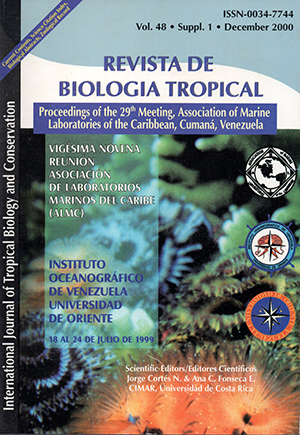Abstract
We examined the spat availability the oyster Pteria colymbus at 6-8 and 19-21 m depths for 15 months (March 1993-June 1994) in Turpialito, Golfo de Cariaco, Venezuela. Spats were trapped using artificial collectors (plastic fílaments in bags, 30 x 60 mm), suspended from a long line. Each collector was replaced by a replica monthly to analyse abundance, shell dimension and mass of P colymbus. Intraweekly, the temperature, salinity, oxygen and food availability (Chlorophylla, total seston, organic and inorganic seston) were determinated. There is juvenile recruitment all year, suggesting continuous reproduction. Spat counts were higher at 6-8 m (generally 50-230 juveniles per collector) with peaks in August and December 1993 (April and June 93 at 19-21 m). The length-weigh mass relation was higher at 19-21 m, suggesting greater food availability because of lower organism density (including P. colymbus) and a greater water flux. Phytoplanktonic abundance and temperature were correlated (r2=0.38) with juvenile abundanc; this relationship and the association of juvenile abundance with higher temperature and Chlorophyll a levels, suggest that spat abundance was higher at the beginning of the water stratification period, when phytoplankton biomass is high.Comments

This work is licensed under a Creative Commons Attribution 4.0 International License.
Copyright (c) 2000 Revista de Biología Tropical
Downloads
Download data is not yet available.


